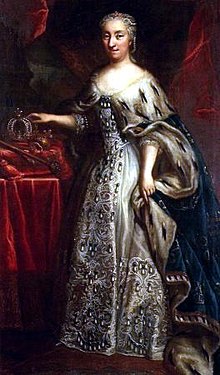Ulrika Eleonore (Sweden)
Ulrika Eleonore (* 23 January July / 2 February 1688 greg. In Stockholm ; † 24 November July / 5 December 1741 greg. Ibid) was the ruling Queen of Sweden from 1718 to 1720 and from 1718 to 1719 Duchess of Bremen-Verden .
Life
Ulrika Eleonore was the second daughter of Charles XI. from Sweden from the house of Wittelsbach ( Pfalz-Zweibrücken-Kleeburg line ) and his wife Ulrike from Denmark .
From around 1713 Ulrika took part in meetings of the Senate because her brother Karl XII. was abroad . With his consent, she signed almost all of the Senate's documents, except those addressed directly to the King.
After the death of her brother on November 30th (July) or December 11th (greg.) 1718, she reacted quickly and was appointed the new queen at a public diet in Uddevalla . The Senate was so taken by surprise that it agreed without protest. The council of war, the only powerful administration after the death of Charles XII, opposed it. In the opinion of the war council, the succession to the throne was not based on the right of inheritance, but was dependent on an election. After Ulrika Eleonore had necessarily consented to this procedure, she was elected queen on January 23, 1719 and crowned on March 17 in Uppsala . With their takeover of the throne, however, a government reform was connected, which transferred the center of power into the hands of the Reichstag.
Already at this time Ulrika wanted to rule together with her husband, Friedrich von Hessen-Kassel , to whom she had been married since 1715, but the Reichstag opposed this request. Regardless of this, her husband got more and more involved in the political process. When Ulrika got into trouble with some Senate members, he took advantage of that argument and won the trust of these men. On February 29, 1720 Ulrika Eleanor finally abdicated in favor of her husband, who as Frederick I was the only Hessian on the Swedish throne. Ulrika's abdication was linked to the condition that she should become queen again if her husband died before her.
After the change in power, she was more concerned with charity matters. Only during a stay abroad (1731) and Friedrich's illness (1738) did she take on government responsibility again. Ulrika was the last Wittelsbach woman on the Swedish throne. Their marriage was childless.
ancestors
| Johann Kasimir von Pfalz-Zweibrücken-Kleeburg (1589–1652) | |||||||||||||
| Charles X. King of Sweden (1622–1660) | |||||||||||||
| Katharina Wasa of Sweden (1584–1638) | |||||||||||||
| Charles XI. King of Sweden (1655–1697) | |||||||||||||
| Friedrich III. of Schleswig-Holstein-Gottorf (1597–1659) | |||||||||||||
| Hedwig Eleonora of Schleswig-Holstein-Gottorf (1636-1715) | |||||||||||||
| Maria Elisabeth of Saxony (1610–1684) | |||||||||||||
| Ulrika Eleonore Queen of Sweden | |||||||||||||
| Christian IV. King of Denmark , (1577–1648) | |||||||||||||
| Friedrich III. King of Denmark (1609–1670) | |||||||||||||
| Anna Katharina of Brandenburg (1575-1612) | |||||||||||||
| Ulrike Eleonore of Denmark (1656–1693) | |||||||||||||
| Georg von Braunschweig-Calenberg (1582–1641) | |||||||||||||
| Sophie Amalie of Braunschweig-Calenberg (1628–1685) | |||||||||||||
| Anna Eleonore of Hessen-Darmstadt (1601–1659) | |||||||||||||
literature
- Marita A. Panzer: Wittelsbach women. Princely daughters of a European dynasty . Pustet, Regensburg 2012, ISBN 978-3-7917-2419-5 , p. 121-133 .
- Ulrika Eleonore . In: Herman Hofberg, Frithiof Heurlin, Viktor Millqvist, Olof Rubenson (eds.): Svenskt biografiskt handlexikon . 2nd Edition. tape 2 : L – Z, including supplement . Albert Bonniers Verlag, Stockholm 1906, p. 660 (Swedish, runeberg.org ).
- Bror Emil Hildebrand: Sveriges och svenska konungahusets minnespenningar, prakmynt och belöningsmedaljer - Internet Archive Kongliga Vitterhets Historie och Antiquitets Akademiens Förlag, Stockholm 1875, p. 17. (Swedish)
Web links
| predecessor | Office | successor |
|---|---|---|
| Charles XII. |
Queen of Sweden
suo iure 1718–1720 |
Friedrich |
| Charles XII. |
Duchess of Bremen-Verden 1718–1719 |
George I. Ludwig |
| Ulrike Eleonore of Denmark and Norway |
Queen consort of Sweden 1720–1741 |
Luise Ulrike of Prussia |
| personal data | |
|---|---|
| SURNAME | Ulrika Eleonore |
| ALTERNATIVE NAMES | Ulrika I. Eleonore; Ulrica Eleonore |
| BRIEF DESCRIPTION | Queen of Sweden |
| DATE OF BIRTH | February 2, 1688 |
| PLACE OF BIRTH | Stockholm |
| DATE OF DEATH | December 5, 1741 |
| Place of death | Stockholm |
